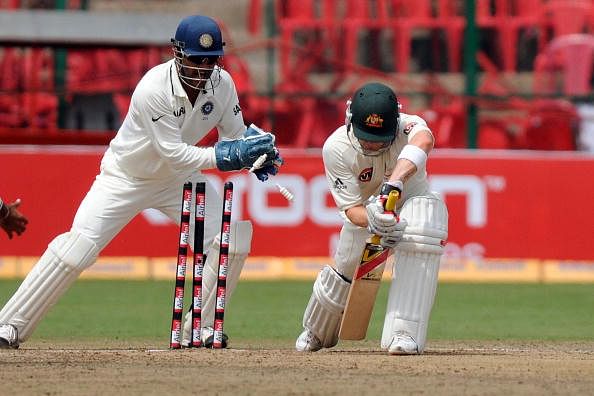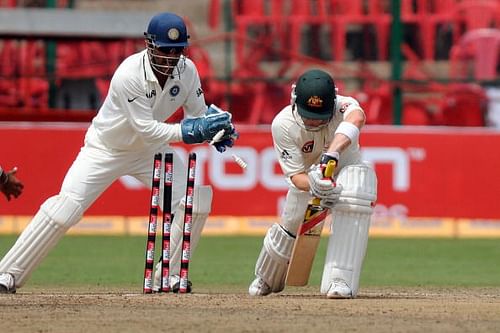
Comparing the Indian and Australian squads for the Border-Gavaskar trophy

When India lost their tag of being the best team in the world after being humiliated by England with a scoreline of 4-0, followed by a similar loss against Australia, lots of questions were raised about the team. It seemed that the team had got back to their tendency of being lions at home and lambs outside. But things turned worse when India lost to England at home, that too on tracks assisting spinners. The English spinners got more assistance from the tracks than their Indian counterparts. The Indian batsmen couldn’t pick the English bowlers while surprisingly, the English batsmen looked more prepared and picked the Indian spinners with ease. This has created doubts about the ability of our batsmen and bowlers at home as well. With Australia touring India for four Test matches, every one is expecting the Indian team to come back strongly and win the Test series comprehensively against a team lacking in experience, whose experienced campaigners Ricky Ponting and Mike Hussey recently retired from international cricket. It’s not going to be easy for the Australians who are touring with a relatively inexperienced squad. Here is a comparison of the squads of the two teams:
Openers
The Indian opening duo of Virender Sehwag, who is one of the most feared batsmen of all time and Gautam Gambhir, who showed his ability to play according to the situation, was one of the reasons for India reaching the number 1 position in Test cricket. With neither of them scoring runs recently, a lot of pressure has been created on the middle order batsmen. India’s loss to England at home made the selectors take the harsh decision of dropping Gambhir, who has not been able to reach the three figure mark in the past two years. With Shikhar Dhawan and Murali Vijay constantly knocking on the door for the opening slot, the selectors had to take the decision of dropping Gambhir despite them know the ability of this southpaw to be consistent. With this change in the opening combination it should be an added incentive for the Australian team to take on the Indian batting order with their pace attack. On the other hand, while the Australian opening pair looks more settled compared to the Indian pair with Ed Cowan and David Warner likely to open, their lack of knowledge of the slow conditions may tilt the scales in favor of the Indians. That said, if Warner gets going it’s going to be tough for the inexperienced Indian pace attack.
Middle order
The Indian and Australian middle orders led by the master Sachin Tendulkar and Michael Clarke respectively are very young. India has the likes of Pujara, Kohli and Jadeja, who have all played less than 10 Tests. Pujara played a crucial knock in India’s only win in the Test series against England and Dhoni and Kohli played against their natural instincts in the fourth Test against England to save India from yet another humiliating defeat. With Sachin scoring an unbeaten century in the Irani Trophy final, the whole middle order looks in decent touch. If they carry on with the same form, the Indian batting concerns should be a thing of the past. With a batsmen like Ajinkya Rahane as backup for the middle order, it’s always a good sign for the team. For Australia, Phil Hughes being in great form and Glenn Maxwell’s all-round performance in the ODI series against West Indies should help the team. Shane Watson coming into the team as a specialist batsmen will reduce some of the pressure on him and will help him to give his best as a batsman. With good performances in the domestic circuit, Moses Henriques has earned his spot in the team as all-rounder ahead of Dan Christian who had a poor season in both BPL and the domestic circuit. With Steve Smith as back-up, the line-up looks in good shape. Both the sides will need their experienced campaigners to act as the anchors around which the youngsters build their innings.
Captaincy
Mahindra Singh Dhoni, skipper of the Indian team, is under the hammer after losing 10 of the last 14 Test matches before this series. There have been many comments about Dhoni’s captaincy being very predictable, his bowling changes not being suited to the situation and field placements being very defensive. The fact that Dhoni has been in good batting form could help him get back to his rhythm of captaincy and win matches for the nation. On the other hand, it’s a complete different story for Clarke, who has been one of the best captains in the past few years. The pressure of leading an inexperienced side may hinder him a bit, but the way his form has been in the past twelve months, he should be confident. His main concern will be his fitness, as he is suffering from a hamstring injury.
Wicket-keeping
Mathew Wade, who has been picked ahead of Brad Haddin as the glovesman, was criticized for his sloppy glove work against Sri Lanka in Australia but he has impressed with the bat. This series is a real test for this southpaw, with the spinning tracks in the subcontinent expected to test him, and he would like to take this as a challenge to prove his ability and shut his critics up.
Spinners
To my mind, the main concern for both the teams is their spin department. For India, Ravinchandran Ashwin, who has been the skipper’s trump card in the past, gave away a lot of runs and found it tough filling the wickets column against England. Harbhajan Singh, who is about to play his 100th Test, is not the same bowler that he used to be in the past and Pragyan Ojha, who was the best bowler for India against England, found it very difficult to pick wickets in the domestic circuit. The positives for the Indian spin bowling include the fact that Harbhajan bowled a good line and length in the Irani Trophy and got wickets with classic off spinner deliveries, and playing against Australia, his favorite opponents, should help his confidence. Also, while Ojha has found it difficult to pick up wickets, he has been very consistent in his approach without giving away any loose deliveries. Another import concern would be the number of spin bowlers in the playing eleven. Dhoni was been criticized for under-utilizing Harbhajan or using him only for containing the batsmen in the Test matches against England. So playing two spinners would be ideal, along with Ravindra Jadeja who can be handy with his left-arm spin. Choosing two out of the three could be the biggest issue for the coach and skipper discuss about. Coming to Australia, Nathan Lyon is the lone spinner who has played a good amount of Test cricket. Xavier Doherty, who is generally an ODI bowler, has been picked in the team keeping the spinner-friendly subcontinent tracks in mind. Doherty has played the containing role until now and has been very successful at it, but playing attacking cricket will be a new challenge for him and we will have to wait and watch how he delivers. Australia may follow the footsteps of England who won against India with two spinners in the team.
Pace attack
The Indian pace attack is very young with the likes of Bhubaneswar Kumar and Ashok Dinda lead by Ishant Sharma who has recently come back from injury. With Ishant and Kumar being in good form in the series against Pakistan and England, the Indian skipper could use them to create good impact with the new ball. Kumar’s ability to swing the ball both the ways at with the new ball and the ability of Ishant to extract extra bounce from the track with his height will make this duo threatening even on a flat batting track. One of the drawbacks in the pace department is the lack of experience; the team will miss the services of Zaheer Khan, who would have been the ideal member to lead the pace attack. The Australian pace attack is also very young but it is a proven bunch. Mitchell Starc who has been in great touch will be the key for the Aussies who are led by Peter Siddle and Mitchell Johnson. With players like Jackson Bird and James Pattinson as back-up, the Australian pace bowling line-up looks more formidable than its Indian counterpart, but it all depends on the way they adapt to the placid flat tracks in India.
Both the teams are in transition phase. A win for either team will give them tremendous confidence. It is an important series for the youngsters in both the teams. On paper both the teams look well-balanced, but India has the home advantage.